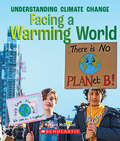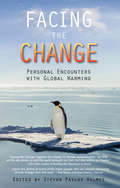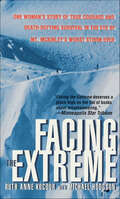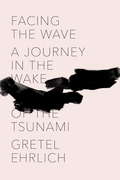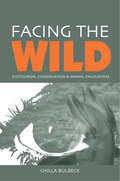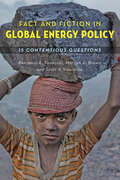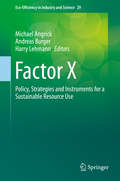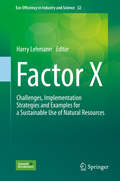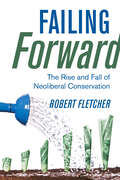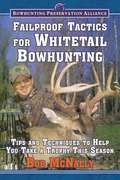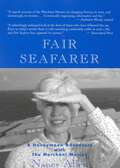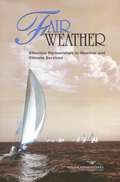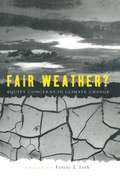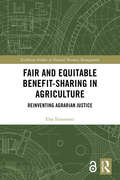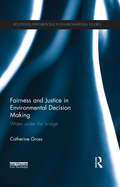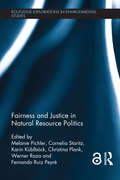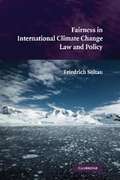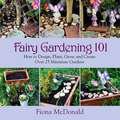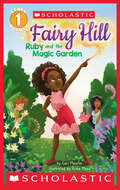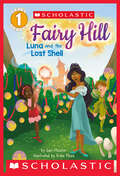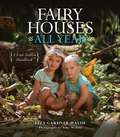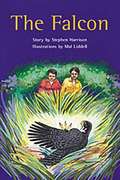- Table View
- List View
Facing a Warming World (A True Book (Relaunch))
by Melissa McDanielHow did scientists come to understand that climate change is happening? And how is it affecting human societies today? This book explores the human response to climate change over the past century. Chapters address the health effects and emotional impact of climate change, as well as how people are working to solve the problem, from protests to political and technological change.Glaciers are melting. Summers are heating up. Sea levels are on the rise. Climate change is affecting every corner of our planet - and it's the subject of a lot of concern, activism, and debate. STEM meets current events in this new A True Book set that offers readers the chance to learn about the causes and effects of climate change, as well as how people around the world are reacting to it. Students will read about the history and scope of the problem, analyze the same kinds of evidence that scientists do, and come away with tools that will help them respond to this pressing global issue.This series covers Next Generation Science Standards core ideas including Weather and Climate, Human Impacts on Earth Systems, Conservation of Energy and Energy Transfer, and Biodiversity and Humans.
Facing the Change
by Steven Pavlos Holmes"Amidst the current deluge of statistics about global warming, this book provides a refreshing look at how individuals are affected. This is a beautiful book to keep near, open at random, and share the words of gifted writers as they prepare for the coming changes."-Publishers Weekly"Holmes, a scholar in environmental humanities, has assembled a rich, varied collection of personal accounts and poems...An artistic and intimate approach to the problem that humanizes our concerns."--Booklist"How do you respond when the familiar, benevolent, and predictable world you count on becomes strange, hostile, and chaotic? First, you must face it. Next, bear witness. Steven Holmes has gathered compelling testimonies about the ways our earthly home is changing in the short space of our own lifetimes. They beg us to pay attention and act. We are wise to heed these passionate voices."-Chip Ward, author of Hope's Horizon"These earnest and heartfelt poems, essays, and imaginings change our discourse from data to personal testimony, channeling 'care and concern.' Maybe, just maybe, these authors who call us to 'unheroic' action 'on life's behalf' will steer us away from tragedy and chaos. 'Emerging from denial is like moving from blindness to light.' As the refrain from one writer puts it, 'Good Lord! Good luck!'"-Stephen Trimble, author of Bargaining for Eden: The Fight for the Last Open Spaces in America"Facing the Change shares the stories of some of the many people in the US and the world who are already witnessing climate change here and now. They are giving us early warning signs; it's up to all of us to act now."-Mae Boeve, executive director of 350.org"Facing the Change registers the impact of climate destabilization, not only on the sky above us and the earth beneath our feet, but also within our hearts. The voices in this eloquent and original book convey the dread and grief, the anger, but also the experiences of love and community that are intensified by the defining ecological challenge of our time."-John Elder, author of Reading the Mountains of Home, editor of The Norton Book of Nature"These eloquent stories, essays, and poems by scores of 'emotional and cultural first responders' to the effects of climate change are sure to deliver a powerful wake-up call to anyone who has supposed that nothing an individual person can say or do will affect this impending disaster."-Lawrence Buell, author of The Environmental Imagination"...the contributors to Facing the Change have begun to reveal the experiential heart of a planetary process. This is a truly important project." -Scott Slovic, editor of ISLE: Interdisciplinary Studies in Literature and EnvironmentFilled not with bare facts and dire warnings but with evocative, accessible stories, essays, and poetry, Facing the Change shows how global warming is affecting the everyday lives of people today. A wide range of writers brings courage, honesty, and insight to one of the major issues of our lives.Steven Pavlos Holmes, Ph.D., is an independent scholar in the environmental humanities, with a special interest in people's personal experiences of the natural world. His first book, The Young John Muir: An Environmental Biography, won the Modern Language Association's Prize for Independent Scholars. He lives in Jamaica Plain, Massachusetts.
Facing the Climate Emergency: How to Transform Yourself with Climate Truth
by Molly Gage Margaret Klein SalamonStop fretting and start fighting global warming: “A remarkable account of how you can become a climate warrior.” —Bill McKibben, founder of 350.orgYes, we’re facing catastrophic breakdown of our climate. Yes, it’s terrifying. But you don’t have to be paralyzed. You can use your pain to transform yourself, your friends, and the world. You can become the hero humanity needs. This book will show you how.Facing the Climate Emergency is an action-oriented self-help guide showing you how to maximize your potential to meet the greatest challenge humanity has ever faced. Written for all of us struggling to cope and wanting to do something to stop the climate crisis, it gives us the blueprint to leave “normal” behind and enter climate “emergency mode.”How to face the climate crisis and accept your fears, anger, grief, guilt, and other emotionsTurning negative feelings into tangible action to respond to the crisisRising to heroism and maximizing your impact by joining the Climate Emergency MovementInformation on further reading, questions for self-reflection, and exercises “This book will wake you up, no matter how aware you think you are.” —David Wallace-Wells, #1 New York Times-bestselling author of The Uninhabitable Earth
Facing the Extreme: One Woman's Story of True Courage and Death-Defying Survival in the Eye of Mt. McKinley's Worst Storm Ever
by Michael Hodgson Ruth Anne KocourRuth Anne Kocour's Facing the Extreme charts her remarkable journey of survival climbing Mount McKinley.She stepped into a death zone. The climbers on Alaska's Mt. McKinley called her "the woman." Ruth Anne Kocour, a world-class mountaineer, wasn't bothered. It was part of the challenge she faced as she joined an all-male team to conquer North America's highest peak...the mountain the Indians called Denali, or God.Faced the extreme. But nine days into this ascent, a forty-fifth birthday present to herself, the most violent weather on record slammed into the mountain. Ruth Anne and her group would be trapped on an ice shelf at 14,000 feet for the deadliest two weeks in Denali history. Pinned down by blinding snows, unable to help other teams dying around her, and her own feet freezing solid, Ruth Anne tells of a wind chill of minus 150 degrees, deadly hidden crevasses, and being trapped in a place so violent and unforgiving that it threatened to push her over the edge and into a place of no return. And yet, in prose as crystalline as the ice around her, she tells, too, of beauty, courage, and the spirit that drives true mountaineers higher, as she risks all to go for the summit...and perhaps, for a transcendent moment, touch heaven.And lived to tell about it ..
Facing the Wave: A Journey in the Wake of the Tsunami
by Gretel EhrlichA passionate student of Japanese poetry, theater, and art for much of her life, Gretel Ehrlich felt compelled to return to the earthquake-and-tsunami-devastated Tohoku coast to bear witness, listen to survivors, and experience their terror and exhilaration in villages and towns where all shelter and hope seemed lost. In an eloquent narrative that blends strong reportage, poetic observation, and deeply felt reflection, she takes us into the upside-down world of northeastern Japan, where nothing is certain and where the boundaries between living and dying have been erased by water. The stories of rice farmers, monks, and wanderers; of fishermen who drove their boats up the steep wall of the wave; and of an eighty-four-year-old geisha who survived the tsunami to hand down a song that only she still remembered are both harrowing and inspirational. Facing death, facing life, and coming to terms with impermanence are equally compelling in a landscape of surreal desolation, as the ghostly specter of Fukushima Daiichi, the nuclear power complex, spews radiation into the ocean and air. Facing the Wave is a testament to the buoyancy, spirit, humor, and strong-mindedness of those who must find their way in a suddenly shattered world.
Facing the Wild: Ecotourism, Conservation and Animal Encounters
by Chilla BulbeckWhat do wild animals mean to humans? Will they survive both rampant habitat loss and extinction caused by human encroachment and, as ecotourists, our enthusiasm for them? With ecotourism now the fastest growing segment of tourism, and encounters with wild animals - be it swimming with dolphins, going on safari or bird watching - ever more popular, these are critical questions. Yet until now little has been known about why people crave encounters with wild animals and the meaning for the ecotourism industry, conservation efforts and society at large. Facing the Wild is the first serious empirical examination of why people seek out animals in their natural environment, what the desire for this experience tells us about the meanings of animals, nature, authenticity and wilderness in contemporary industrialized societies, and whether visitors change their environmental perspectives and behaviour, as the custodians of wildlife parks would like them to. The book explores the contradictions and ambivalence that so many people experience in the presence of 'wild nature' - in loving it we may diminish it and in the act of wanting to see it we may destroy it. Ultimately the book makes a case for 'respectful stewardship' of a 'hybrid nature' and provides insight for both practitioners and ecotourists alike.
Fact and Fiction in Global Energy Policy: Fifteen Contentious Questions
by Benjamin K. Sovacool Marilyn A. Brown Scott V. ValentineA balanced examination of global energy issues.Energy sustainability and climate change are two of the greatest challenges facing humankind. Unraveling these complex and interconnected issues demands careful and objective assessment. Fact and Fiction in Global Energy Policy aims to change the prevailing discourse by examining fifteen core energy questions from a variety of perspectives, demonstrating how, for each of them, no clear-cut answer exists.Is industry the chief energy villain? Can we sustainably feed and fuel the planet at the same time? Is nuclear energy worth the risk? Should geoengineering be outlawed? Touching on pollution, climate mitigation and adaptation, energy efficiency, government intervention, and energy security, the authors explore interrelated concepts of law, philosophy, ethics, technology, economics, psychology, sociology, and public policy.This book offers a much-needed critical appraisal of the central energy technology and policy dilemmas of our time and the impact of these on multiple stakeholders.
Factor X
by Harry Lehmann Andreas Burger Michael AngrickFactor X: Re-source--Designing the Recycling Society explores the role of recycling in efforts to achieve the sustainable world envisioned in the Federal Environment Ministry's Resource Efficiency Programme, known as ProgRess. The chapters build a roadmap to a Recycling Society in which the decoupling of resource consumption and economic growth is accomplished.
Factor X
by Harry LehmannFactor X: Re-source Designing the Recycling Society explores the role of recycling in efforts to achieve the sustainable world envisioned in the Federal Environment Ministry s Resource Efficiency Programme, known as ProgRess. The chapters build a roadmap to a Recycling Society in which the decoupling of resource consumption and economic growth is accomplished. "
Failing Forward: The Rise and Fall of Neoliberal Conservation
by Robert FletcherFailing Forward documents the global rise of neoliberal conservation as a response to biodiversity loss and unpacks how this approach has managed to "fail forward" over time despite its ineffectiveness. At its core, neoliberal conservation promotes market-based instruments intended to reconcile environmental preservation and economic development by harnessing preservation itself as the source of both conservation finance and capital accumulation more generally. Robert Fletcher describes how this project has developed over the past several decades along with the expanding network of organizations and actors that have come together around its promotion. Drawing on Lacanian psychoanalysis, he explores why this strategy continues to captivate states, nongovernmental organizations, international financial institutions, and the private sector alike despite its significant deficiencies. Ultimately, Fletcher contends, neoliberal conservation should be understood as a failed attempt to render global capitalism sustainable in the face of its intensifying social and ecological contradictions. Consequently, the only viable alternative capable of simultaneously achieving both environmental sustainability and social equity is a concerted program of "degrowth" grounded in post-capitalist principles.
Failproof Tactics for Whitetail Bowhunting: Tips and Techniques to Help You Take a Trophy This Season (Bowhungting Preservation Alliance Ser.)
by Bob McnallyFail-proof Tactics for Whitetail Bowhunting has it all! Veteran bowhunter Bob McNally brings together in one book the tips, tricks, and masterful secrets of the masters of whitetail bowhunting. More than thirty bowhunters-with six hundred years deer bowhunting experience and five thousand whitetails harvested between them-offer their sage advice on taking this most popular of North American big game animals.Learn how to: Choose the hunting bow that's right for you Manage land for BIG bucks! Shoot a bow accurately Call and decoy deer Hunt the rut Find choice deer foods Pick hot tree stand sites Use trail cameras Plan bowhunts the right way And so much more you need to know! Failproof Tactics for Whitetail Bowhunting includes top whitetail hunters like Mark Drury, Matt Morrett, Fred Bear, Ted Nugent, Bill Jordan, Jim Crumley, Harold Knight, Ralph Cianciarulo, Stan Potts, David Blanton, Claude Pollington, Will Primos, and many others. If you're looking to improve your chances of taking a deer this season, look no further! Learn from the experts; get bigger, better bucks.
Fair Seafarer: A Honeymoon Adventure with the Merchant Marine
by Nancy AllenA gutsy woman's tale of marrying the Chief Mate of a mammoth containership and sailing the seas with today's modern mariners.
Fair Weather: Effective Partnership in Weather and Climate Services
by Committee on Partnerships in WeatherDecades of evolving U.S. policy have led to three sectors providing weather services--NOAA (primarily the National Weather Service [NWS]), academic institutions, and private companies. This three-sector system has produced a scope and diversity of weather services in the United States second to none. However, rapid scientific and technological change is changing the capabilities of the sectors and creating occasional friction. Fair Weather: Effective Partnerships in Weather and Climate Services examines the roles of the three sectors in providing weather and climate services, the barriers to interaction among the sectors, and the impact of scientific and technological advances on the weather enterprise. Readers from all three sectors will be interested in the analysis and recommendations provided in Fair Weather.
Fair Weather: Equity concerns in climate change
by Ferenc L TóthIs a unique, cross-disciplinary assessment of fairness and equity issues in the context of global climate change - a crucial dimension in current international negotiations - written by a collection of leading scientists in economics, sociology and social psychology, ethics, international law and political science. How should responsibility for adapting to climate change be distributed? Who should bear the costs of mitigating its impacts and how should these costs be measured? Answers to these questions differ, often according to the vulnerability, wealth and level of industrial development of the country. Finding a fair solution is controversial, but crucial to the complex and vital negotiations over global warming. This illuminating and accessible volume explores the policy dimensions and analytical needs of the negotiation process. It is essential reading for policy makers and students and teachers of economics, sociology and social psychology, ethics, international relations, law and political science. FERENC L TOTH is project leader at the Department of Global Change and Social Systems at the Potsdam Institute for Climate Impact Research (PIK), Germany. CONTRIBUTORS H Asbjorn Aaheim Frank Biermann Samuel Fankhauser Carsten Helm Juliane Kokott Joanne Linnerooth-Bayer Volker Linneweber Elizabeth L Malone Shuzo Nishioka Originally published in 1999 David W Pearce Steve Rayner P R Shukla Dominik Thieme Michael Thompson Richard S J Tol David G Victor
Fair and Equitable Benefit-Sharing in Agriculture: Reinventing Agrarian Justice (Earthscan Studies in Natural Resource Management)
by Elsa TsioumaniThis book explores the emergence and development of the legal concept of fair and equitable benefit-sharing, and its application in agriculture. Developed in the 1990s, the concept of fair and equitable benefit-sharing has been deployed in an ever-wider variety of international instruments, including those on biodiversity, climate change, and human rights. A lack of clarity persists however on what fair and equitable benefit-sharing requires and entails, and whether its implementation supports or eventually undermines equity and justice. This book examines these questions in the area of land, food and agriculture, addressing, for the first time, several instances of the agricultural production chain, including research and development, land governance and land use, and access to markets. It identifies challenges regarding implementation of the concept as enshrined in environmental treaties and soft-law instruments, with a focus on the International Treaty on Plant Genetic Resources for Food and Agriculture, the Voluntary Guidelines on Tenure and the UN Declaration on the Rights of Peasants. It investigates its role, enabling conditions and limitations, in a contradictory policy context involving environmental, food security and human rights objectives but also a growing web of multilateral and bilateral trade and investment agreements. Linking international law research with a socio-legal analysis, the book addresses four grassroots examples, which offer ideas for institutional and legal innovation from the local to the global level. This interdisciplinary title will be of great interest to students and scholars of international environmental law, agriculture, land law, development studies and international governance, as well as policymakers and practitioners working in these fields.
Fairness and Justice in Environmental Decision Making: Water Under the Bridge (Routledge Explorations in Environmental Studies)
by Catherine GrossBy crossing disciplinary boundaries, this book uniquely connects theories of justice with people's lived experience within social conflicts over resource sharing. It shows why some conflicts, such as local opposition to wind farms and water disputes, have become intractable social problems in many countries of the world. It shows the power of injustice in generating opposition to decisions. The book answers the question: why are the results of many government initiatives and policies not accepted by those affected? Focusing on two social conflicts over water sharing in Australia to show why fairness and justice are important in decision-making, the book shows how these conflicts are typical of water sharing and other natural resource conflicts experienced in many countries around the world, particularly in the context of climate change. It tells the stories of these conflicts from the perspectives of those involved. These practically-based findings are then related back to ideas and constructs of justice from disciplines such as social psychology, political philosophy and jurisprudence. With a strong practical focus, this book offers readers an opportunity to develop a deep understanding of fairness and justice in environmental decision-making. It opens up a wealth of fairness and justice ideas for decision-makers, practitioners, and researchers in natural resource management, environmental governance, community consultation, and sustainable development, as well as people in government and corporations who interface and consult with communities where natural resources are being used.
Fairness and Justice in Natural Resource Politics (Routledge Explorations in Environmental Studies)
by Cornelia Staritz Melanie Pichler Karin Küblböck Christina Plank Werner Raza Fernando Ruiz PeyréAs demand for natural resources increases due to the rise in world population and living standards, conflicts over their access and control are becoming more prevalent. This book critically assesses different approaches to and conceptualizations of resource fairness and justice and applies them to the analysis of resource conflicts. Approaches addressed include cosmopolitan liberalism, political economy and political ecology. These are applied at various scales (local, national, international) and to initiatives and instruments in public and private resource governance, such as corporate social responsibility instruments, certification schemes, international law and commodity markets. In doing so, the contributions contrast existing approaches to fairness and justice and extend them by taking into account the interplay between political scales, regions, resources, and power structures in "glocalized" resource politics. Various case studies are included concerning agriculture, agrofuels, land grabbing, water resources, mining and biodiversity. The volume adds to the academic and policy debate by bringing together a variety of disciplines and perspectives in order to advance both a research and policy agenda that puts notions of resource fairness and justice center-stage.
Fairness in International Climate Change Law and Policy
by Friedrich SoltauThis work analyses fairness and equity dimensions of the climate regime. A central issue in international law and policy is how countries of the world should allocate the burden of addressing global climate change. With the link between human activities and climate change clearly established, and the first impacts of climate change being felt, there is a renewed sense of urgency in addressing the problem. Based on an overview of science and the development of the climate regime to date, this book seeks to identify the elements of a working consensus on fairness principles that could be used to solve the hitherto intractable problem of assigning responsibility for combating climate change. The book demonstrates how an analysis of fairness dimensions of climate change - grounded in practical developments and illustrated with reference to the latest developments - can add value to our understanding of current developments and future options for international climate law and policy.
Fairy Dusters and Blazing Stars: Exploring Wildflowers with Children
by Suzanne SamsonThe literal interpretations of the common names of wildflowers introduce kids to the basics of plant identification.Ages 6-10
Fairy Gardening 101: How to Design, Plant, Grow, and Create Over 25 Miniature Gardens
by Fiona McdonaldRelease your inner child and step into the fairy world by creating your own enchanted garden, no matter how much space you have! Fairy gardens are increasing in popularity and Fairy Gardening 101 provides you with all the information necessary to design, plant, and care for your very own miniature garden oasis. Author, artist, and fairy gardener extraordinaire Fiona McDonald introduces readers to the history of fairy gardens and then provides step-by-step instructions, photographs, and illustrations for you to follow-or draw inspiration from-when starting your own project.Learn which types of plants and containers are most successful for a fairy garden, as well as how to develop a focal point for your enchanted mini Eden. Fairy Gardening 101 also provides important information on caring for your garden, on designing gardens for both indoors and outside, on using artificial plants to make your garden last a lifetime, and much more! You'll also find inspirational photos from fairy gardeners around the globe as well as a list of suppliers. You don't need to be a master gardener or to have a particularly green thumb to successfully plant and maintain your tiny fairy garden. All you need is a few miniature plants, some thoughtfully placed accessories, a fairy or two, and a love of whimsy and imagination.
Fairy Hill: Fairy Hill #1) (Scholastic Reader, Level 1)
by Cari MeisterMeet the magical fairies of Fairy Hill!Fairy Hill is a magic forest where fairies live, play, and have lots of sparkly adventures in this Level 1 reader series! Ruby, Luna, and May are best friends. These young fairies are all looking forward to earning their big wings from the Fairy Queen. But first they each have to do something extra kind or brave. In book #1, Ruby, May, and Luna discover that Fairy Hill's magic garden has lost its sparkle! The fairies try everything to make the garden shine again, but nothing works. Then, a lost baby deer comes to the garden for help. The only way to help it find its way home is to feed it magic clover. Then Ruby has an idea! Will she be able to fix the garden and help the baby deer? Will the Fairy Queen visit the fairy friends?
Fairy Hill: Fairy Hill #2) (Scholastic Reader, Level 1)
by Cari MeisterIt's time for another adventure in Fairy Hill!Fairy Hill is a magic forest where fairies live, play, and have lots of sparkly adventures in this Level 1 reader series! Ruby, Luna, and May are best friends. These young fairies are all looking forward to earning their big wings from the Fairy Queen. But first they each have to do something extra kind or brave. In book #2, a magic shell goes missing! Without it, the glow globes that light up Fairy Hill will all go dark -- and the Fairy Queen will have to cancel the Fairy Ball! Luna, Ruby, and May go looking for the shell. They find out a chipmunk is using it to light his tree. Luna has an idea to get the shell back! Will she be able to bring the light back to Fairy Hill before the ball?
Fairy Houses All Year: A Four-Season Handbook
by Liza Gardner WalshFairy Houses All Year celebrates the year-round pleasures of fairy house building. Through the use of seasonal varieties, kids and families can engage in this natural and creative endeavor through all seasons. The book will highlight activities and materials found in each season. For example, fall fairy houses feature vibrant colored leaves, pumpkins, and late blooming flowers. Winter fairy houses are built using snow, ice, old birds&’ nests, or the dried husks of milkweed and seed pods. In spring, fairy houses become abundant with early blooms, bare branches, and lots of mud! Summer fairy houses are perhaps the most decorative. Choices for the summer fairy house are boundless.Filled with color photos, snippets of fairy lore, helpful advice and instructions, and lots of information about nature, Fairy Houses All Year is the ideal handbook for crafting fairy homes no matter the season. , , ,
Falcon
by Tim JessellA young boy imagines what it would be like to fly as a falcon and see the world from on high. Soaring through the skies, he describes the sights and sounds of the world below. From snow-capped mountains to lush valleys, over rolling ocean and up rocky cliffs, Falcon will awaken the senses of every reader.From the Hardcover edition.
Falcon (Rigby PM Chapter Books Emerald Levels 25-26, Fountas & Pinnell Select Collections Grade 3 Level P)
by Stephen HarrisonCarlos and Ricky arrive at a campsite with their father, where they discover a large injured bird. Dad identifies it as a falcon and he calls a nearby rescue center. Max and Lisa, from Raptor Center, put the falcon in a cage and take it back with them. The falcon does well and Max suggests the boys come to watch the release of the falcon in a few weeks. Later, the boys and their parents go to the place where the bird will be released. Their father tells them they should feel proud about helping to save the falcon, which flies off into the distance.
